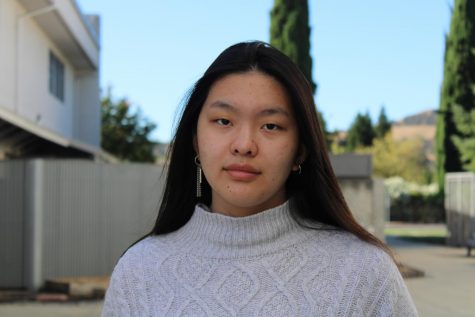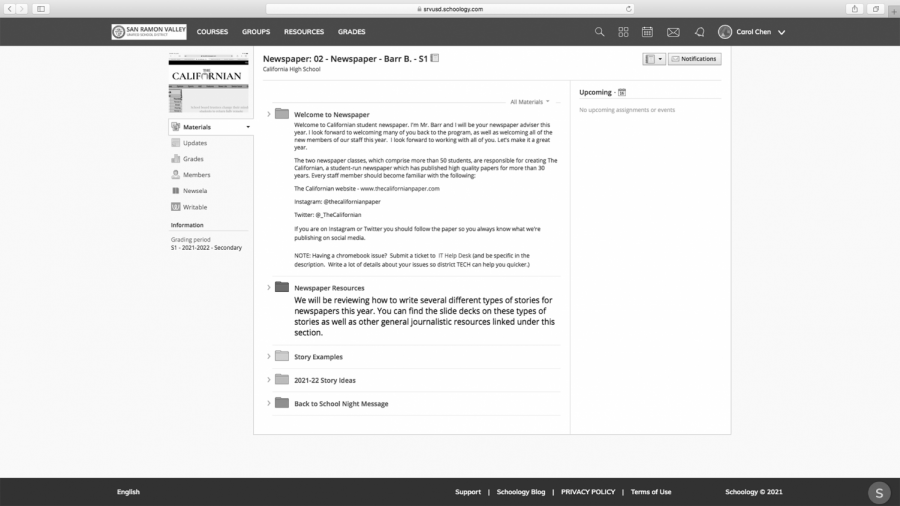How was Schoology selected?
Committee of admin, staff and students reviewed learning platforms before making decision
The class interface of Schoology shows students folders with everything from class materials to announcements.
With the San Ramon Valley Unified School District adopting Schoology this school year, some students are wondering how exactly they ended up using a new platform to check grades and submit assignments.
It all started in October 2020 when a committee was formed by the district to help pick a new learning management system, Christopher George, the district’s director of secondary instruction, said.
A learning management system, or LMS, is an all-encompassing platform like Schoolloop and Google Classroom used for learning and grading. George said the shift to remote learning caused by the pandemic heightened the need for a new LMS. The district wanted to use a methodical process to find one.
“We were going to need a better tool than we currently had for remote learning,” George said. “What we were seeing was a lot of school districts around us kinda hastily just ‘pick one of the shelf’.”
The district temporarily used Google Classroom and Infinite Campus together. George said Infinite Campus was difficult to deal with, so the district acquired a one-year contract with Schoolloop until the committee could find a new platform.
The committee included 83 people on paper as of late January, with the number of people increasing over time since the committee was formed, according to a committee spreadsheet acquired by The Californian. Only eight students were on the committee, three of whom were from Cal High, but not all were active on the committee.
Administrators volunteered to join the committee while parents were chosen by San Ramon Valley PTA President Lisa Gross, according to Gross and the San Ramon Valley Education Foundation. Staff were chosen in collaboration with California School Employees Association, a union representing classified employees, and with San Ramon Valley Education Association, which represents teachers.
Students on the committee were referred to district staff who led the committee by site administration.
Iron Horse Middle School eighth-grader Sofia Avila received an email in October 2020 from Research, Evaulation, and Student Support Coordinator Sarah Acosta Landry thanking her for applying for the committee. But Avila did not know she had been put on the committee.
She found out from sending a follow-up email to Acosta Landry and learned that then-vice principal Nikki Chaplan had recommended her.
Avila couldn’t attend any of the committee meetings but was involved in the sandbox phase of the LMS selection process during second semester, when teachers and students trialed each of the four finalists for two weeks each.
“I don’t think there was any one platform that I liked, and I remember I really hated Schoology,” Avila said. “I didn’t really like it because I thought it was hard to find things. I’d click the bell thing and then there’d be all these notifications.
“Now I like it more,” Avila continued, “but at first it was like ‘What is this, how does this even work?’”
Cal students were selected to be on the committee by administrators through site council, with the process of finding students extending past the committee’s creation in October through second semester.
“It was just opened up during a school site council [meeting],” said Cal senior Sophia Kraskowsky, who was selected to be on the committee by January according to the committee spreadsheet.
Kraskowsky had time conflicts preventing her from attending any meetings. But the first email she recieved to attend a meeting was on March 23, at least two months after she had been placed on the committee.
The committee posted a request for proposals from companies who wanted to provide their LMS to the district in January, according to the March 30 district board presentation about the committee. District Director of Technology Greg Pitzer said the committee received eight bids.
After bids were sent to the district, an internal subcommittee of the committee narrowed the eight bids to four finalists, including Schoology. Schoolloop did not submit a request, George said.
The four finalists were Canvas, Desire2Learn, itslearning, and Schoology, English teacher Devan Manning said.
“Most of the teachers on the committee were on the sandbox so they got to test out the platforms,” said Manning, who served on the committee.
Manning trialed the various platforms, including simulated students. One of her concerns with Schoology was that she believed parents would see assignments out of context and not understand how they were used in class.
“Sometimes it can be weird, when parents look at information when they don’t know the backstory of what was going on in class,” Manning said.
Manning evaluated the platforms and voted for Canvas as her first choice.
However, the committee aspired to use a consensus-based decision-making process.
“We did not take a vote, we just kept discussing it until the group wanted to go one direction or not,” George said.
Despite this, there were two final polls conducted to choose a LMS and Schoology won both, with 83.3 percent of the votes for the elementary poll and 78.1 percent of the secondary poll.
Schoology was chosen because it met 168 out of the 176 criteria set by the committee, and the grade book was able to provide both standard-based and traditional grading methods, as opposed to Google Classroom. This was an important factor in determining a new LMS for the district, Pitzer said.
“I think Schoology was chosen because it works easier for all – elementary, middle and high school,” Manning said.
Pitzer said the district signed a three-year contract with Schoology for $135,000. The district purchased premium support for an additional $38,000.
The support level will most likely reduce after this first year, based on how much the students need it. The district estimates website hosting will cost about $40,000 per year.

Senior Carol Chen joins the Californian as an artist for the second time, after taking a break during junior year. This year, she plans to experiment...





